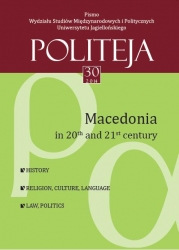The Real and Imagined Enemy in the Process of Shaping the Macedonian National Identity
The Real and Imagined Enemy in the Process of Shaping the Macedonian National Identity
Author(s): Lilla Moroz-GrzelakSubject(s): Social Sciences
Published by: KSIĘGARNIA AKADEMICKA Sp. z o.o.
Keywords: Macedonian national identity; the real enemy; the imagined enemy; black legend of the Jesuits
Summary/Abstract: The article deals with the issues associated with creating thenotion of the enemy in the Macedonian territorial area underlining that image of the enemy was closely related to notion of potential threat. It was strengthened by the geopolitical situation after the year 1878, which led to the formation of the modern Macedonian national identity. On the basisof various textsbelonging tothe Macedonian cultural heritage (including G. Pulevski, K. Misirkov, S. Verković) we can recognize the transfer of the black legend of the Jesuits into the Macedonian territory. In the Macedonian literature at the turn of the 20th century, next to the existing real enemies (Turks, the Greek Church hierarchy (Phanariots)), also appeared an imaginary enemy, represented by the Jesuits. They became the model enemy who was the incarnation of evil fighting against the Orthodoxy and striving for control over the enslaved Slavs by the use of lies, treachery and falsehood. When creating this “enemy” the Macedonian literature used all the elements of the black legend of the Jesuits which existied earlier in Western Europe, and this contributed to the dissolution of the order in 1773. In the article it is noted that the Russian policy towards the Slavic peoples of the Balkans used concepts of the ethnic and religious unity in the Macedonian lands as opposed by the negative image of Catholicism and the “black legend” of the Jesuits, that was already successfully used in other circumstances.
Journal: Politeja - Pismo Wydziału Studiów Międzynarodowych i Politycznych Uniwersytetu Jagiellońskiego
- Issue Year: 11/2014
- Issue No: 30
- Page Range: 133-144
- Page Count: 12

